Physical Address
304 North Cardinal St.
Dorchester Center, MA 02124
Physical Address
304 North Cardinal St.
Dorchester Center, MA 02124
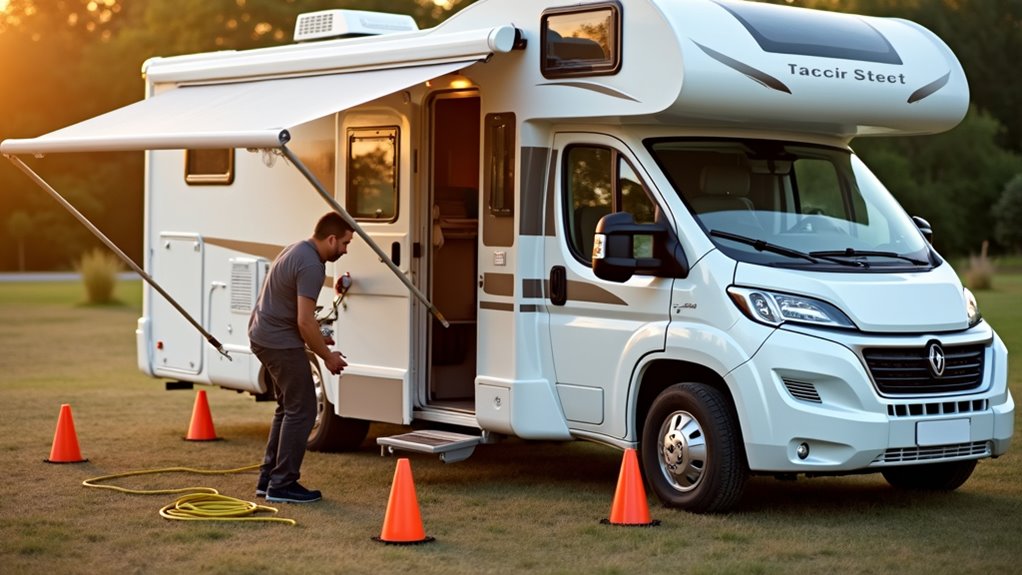
Uncover the hidden motorhome safety secrets that could prevent 70% of RV accidents before your next adventure.
You’re part of the 11 million American households that own an RV, but here’s what most don’t realize—nearly 70% of motorhome accidents stem from preventable oversights that happen before you even hit the road. Whether you’re a weekend warrior or full-time nomad, the difference between a dream trip and a nightmare often comes down to understanding a few critical safety protocols that experienced RVers wish they’d known from day one.
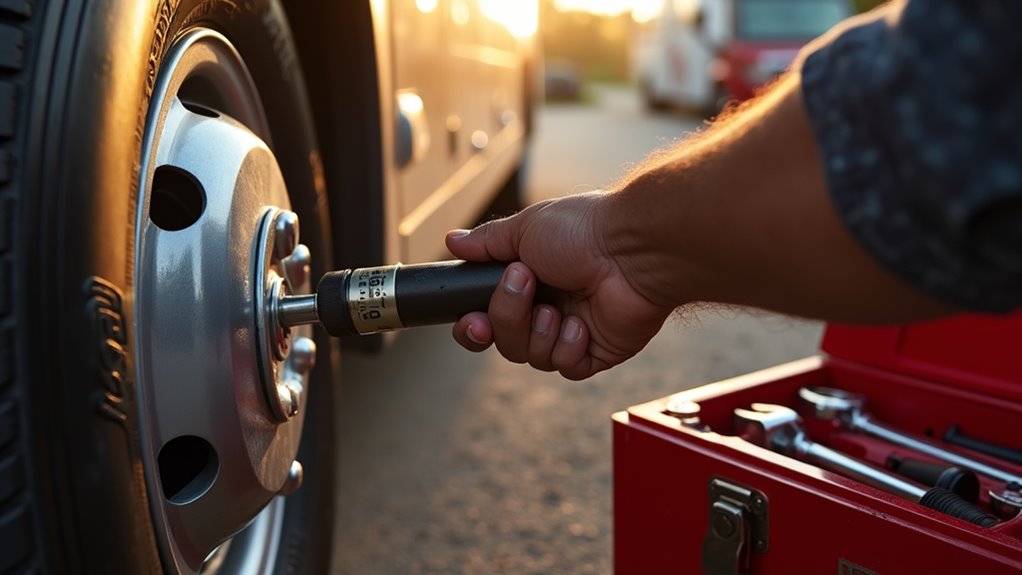
Before you hit the road in your motorhome, you’ll want to conduct a thorough inspection to catch potential problems that could leave you stranded or create dangerous situations. Check your tires for proper pressure, tread depth, and sidewall damage.
A comprehensive pre-trip inspection of your motorhome helps identify potential issues before they strand you on the road.
Inspect all lights, including headlights, taillights, brake lights, and turn signals. Test your brakes and examine fluid levels for engine oil, coolant, transmission fluid, and brake fluid.
Don’t forget your RV-specific systems. Verify your propane connections are secure and leak-free using soapy water. Test your electrical systems, including your house batteries and charging system.
Check your awning hardware and stabilizing jacks for proper operation. Finally, ensure your fire extinguisher and smoke detectors work correctly. A thorough pre-trip inspection prevents breakdowns and keeps you safe.
Just like preparing for any family camping adventure, having a detailed checklist will help ensure you don’t overlook critical safety components during your motorhome inspection.
When you’re loading your motorhome, you’ll need to distribute weight evenly to maintain stability and control on the road. Improper loading can cause dangerous swaying, tire blowouts, and handling problems that put you at risk.
Place heavy items low and toward the center of your RV. Avoid loading everything in the rear compartments, as this creates tail-heavy conditions that affect steering and braking. Always secure loose items before driving.
Key loading guidelines:
Stay within your motorhome’s weight limits and weigh your loaded vehicle regularly. If you’re planning to camp in remote areas like the Himalayas, proper weight distribution becomes even more critical for navigating challenging terrain while maintaining wild animal safety awareness.
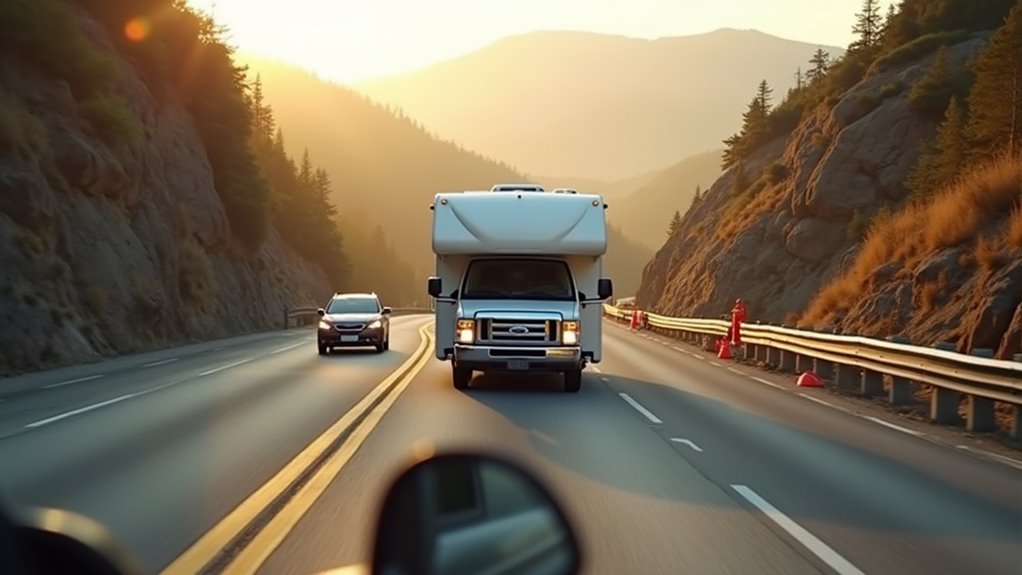
Driving a motorhome requires different skills and techniques than operating a standard car, since you’re now commanding a vehicle that’s considerably longer, wider, and heavier. Maintain larger following distances—at least four seconds behind other vehicles.
Motorhomes demand specialized driving skills due to their increased size, weight, and dimensions compared to standard passenger vehicles.
Take turns slower and wider, watching your tail swing and rear overhang. Check mirrors constantly, especially before changing lanes or turning. Use your turn signals earlier than usual to give other drivers ample warning.
Avoid sudden movements—accelerate, brake, and steer gradually. Drive defensively and assume other drivers don’t see you. Keep speeds moderate, particularly in crosswinds or when descending hills.
Practice parking and backing up in empty lots before hitting the road. Remember, you can’t stop or maneuver as quickly as smaller vehicles. If you’re considering different vehicle options for your outdoor adventures, weigh whether renting or buying might be the better financial choice for your specific travel frequency and budget.
Since motorhomes combine living quarters with vehicle operation, they present unique fire risks that require proactive prevention measures. You’ll need to regularly inspect all propane connections, electrical systems, and appliances for signs of wear or damage.
Install multiple smoke and carbon monoxide detectors throughout your RV, testing them monthly and replacing batteries annually.
Essential fire prevention and emergency preparedness steps include:
While motorhome travel offers incredible access to remote destinations, including glacier climbing trails in mountainous regions, the isolation of these locations makes emergency preparedness even more critical.
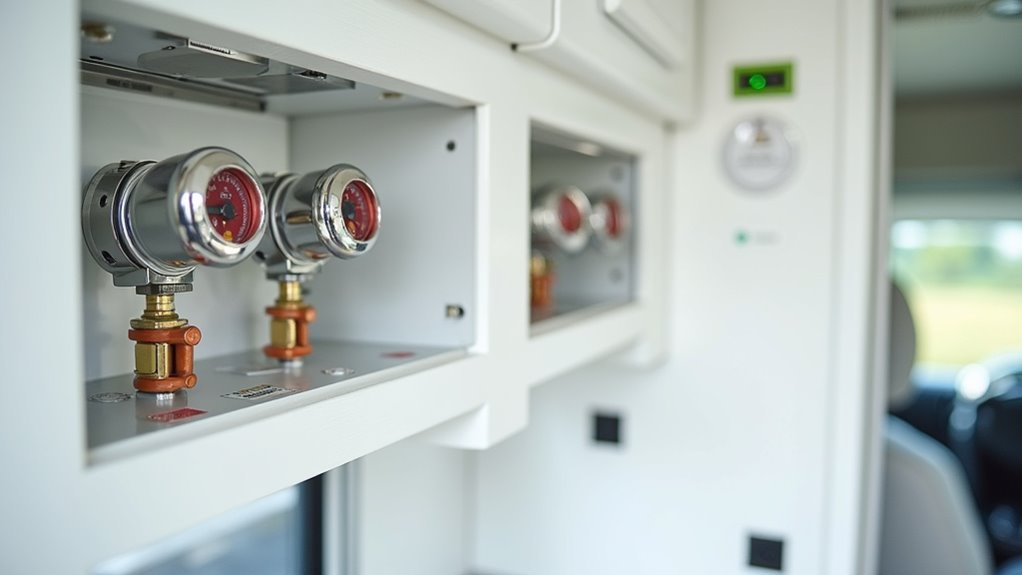
Although motorhomes offer the convenience of home-like amenities on the road, their electrical and propane systems demand constant vigilance to prevent dangerous malfunctions. You’ll need to inspect electrical connections regularly for loose wires, corrosion, or burn marks that signal potential hazards. Don’t overload circuits by plugging in too many devices simultaneously.
For propane safety, check all connections with soapy water to detect leaks – bubbles indicate dangerous gas escapes. Install propane and carbon monoxide detectors, and test them monthly. Turn off propane tanks when driving and never use propane appliances while refueling.
Keep your RV well-ventilated when using gas appliances, and have a certified technician service both electrical and propane systems annually to catch problems before they become emergencies. Understanding proper safety protocols becomes even more crucial when considering that RV camping represents just one of many outdoor adventure styles, each with its own unique safety requirements.
When you arrive at your campsite, securing your motorhome properly protects both your investment and your peace of mind. Taking the right precautions prevents theft and keeps your RV stable during your stay.
Start by choosing your spot wisely. Level ground reduces stress on your motorhome’s frame and makes setup easier. Always engage your parking brake and use wheel chocks on both sides of your tires to prevent rolling.
Essential security measures include:
For those new to motorhome travel, RV camping offers an excellent way to experience outdoor adventures while maintaining the security and comfort of your mobile home base.
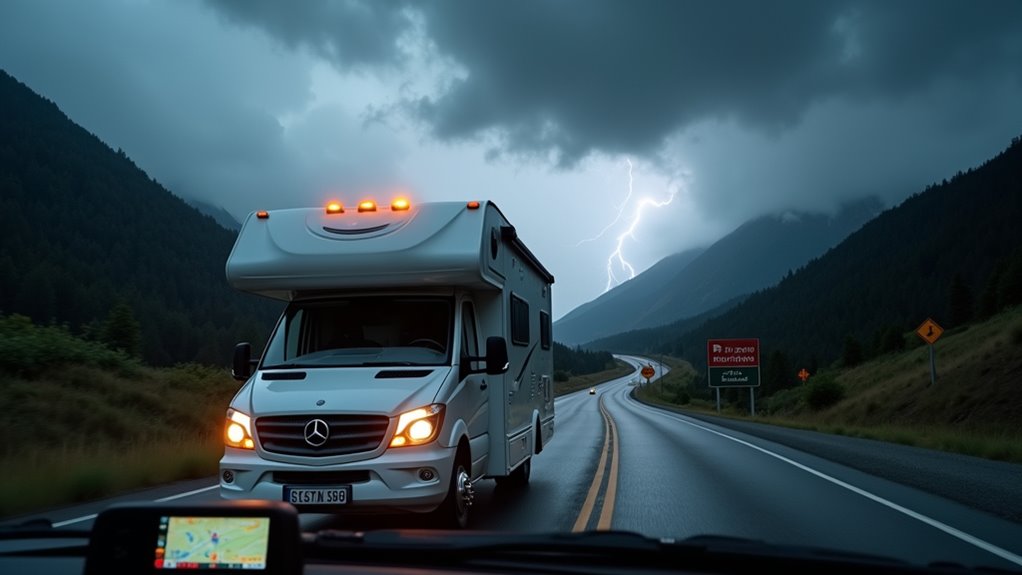
Beyond securing your motorhome at the campsite, you’ll need to plan your travels around Mother Nature’s unpredictable moods. Check weather forecasts along your entire route, not just your destination. High winds can make driving dangerous, especially for tall motorhomes. Avoid mountain passes during snowstorms and desert routes during extreme heat warnings.
Download weather apps that provide real-time updates and radar maps. Plan alternate routes in case conditions deteriorate. Leave early morning when winds are typically calmer, and avoid driving during severe weather warnings.
Monitor road conditions through state DOT websites and apps. They’ll alert you to closures, construction, and hazardous conditions. Keep emergency supplies like extra water, food, and warm clothing. If weather turns severe, pull over safely and wait it out. Modern camping gear now includes portable weather stations and satellite communicators that can provide crucial updates even in remote areas without cell service.
While weather poses external threats to your journey, protecting yourself and your belongings from theft requires a different set of precautions. You’re fundamentally carrying your home on wheels, making you a potential target for criminals who assume you’re carrying cash, electronics, and valuable gear.
Stay vigilant in unfamiliar areas and trust your instincts when something feels off. Park in well-lit, populated areas whenever possible, and avoid isolated spots that provide cover for thieves.
When planning family adventures that involve overnight stays in scenic locations, research the area’s safety reputation and local crime statistics beforehand.
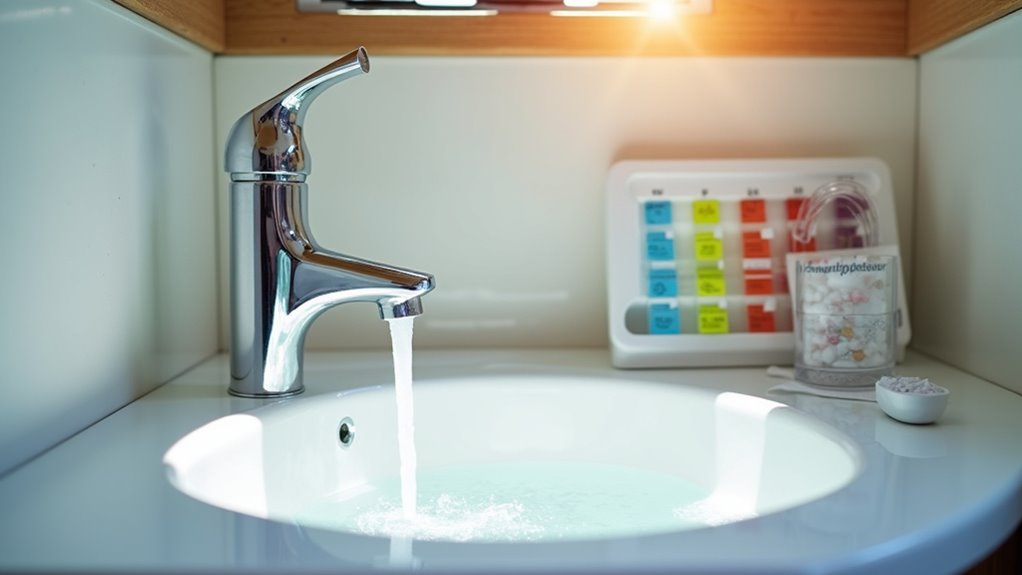
Just as you protect your belongings from external threats, you must safeguard your health by maintaining a clean and safe water system in your motorhome. Start by sanitizing your fresh water tank monthly using a bleach solution—one tablespoon per fifteen gallons of water. Let it sit for several hours, then flush thoroughly until there’s no chlorine smell.
Always use a drinking water hose, not a regular garden hose, when filling your tank. Test your water quality regularly with portable test strips to check for bacteria and contaminants.
Don’t forget to drain and sanitize your hot water heater seasonally.
Keep your gray and black water tanks clean by using appropriate chemicals and flushing regularly. Never drink from questionable water sources without proper filtration or purification tablets.
Before committing to motorhome travel, consider whether this camping style aligns with your comfort preferences and travel goals.
When your motorhome breaks down in remote areas, you’ll need reliable communication methods to summon help and keep loved ones informed of your situation.
Don’t rely solely on your cell phone, as coverage can be spotty in remote locations. Invest in multiple communication options and establish clear protocols before you hit the road.
Essential emergency communication tools include:
Test all devices before departing and keep backup power sources charged.
Inform someone of your travel route and expected arrival times.
Plus, pack camping showers and hygiene supplies in your emergency kit to maintain cleanliness during extended roadside waits or overnight stays while awaiting repairs.
You’ve got the knowledge to travel safely—now put it into practice. Here’s a sobering reality: according to the National Highway Traffic Safety Administration, motorhomes are involved in accidents at twice the rate of regular passenger vehicles. Don’t become part of that statistic. Your thorough preparation, defensive driving, and constant vigilance can make the difference between a memorable adventure and a dangerous situation. Stay alert, follow these guidelines, and you’ll enjoy countless safe journeys ahead.